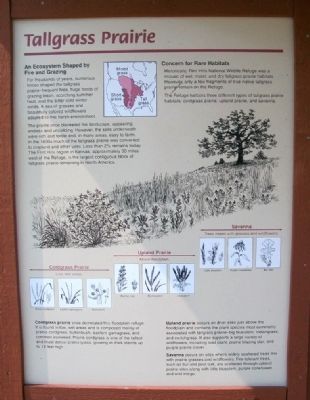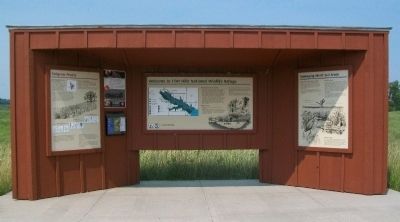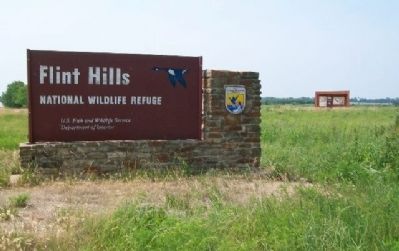Tallgrass Prairie
An Ecosystem Shaped by Fire and Grazing
For thousands of years, numerous forces shaped the tallgrass prairie - frequent fires, huge herds of grazing bison, scorching summer heat, and the bitter cold winter winds. A sea of grasses and beautifully colored wildflowers adapted to this harsh environment.
The prairie once blanketed the landscape, appearing endless and unyielding. However, the soils underneath were rich and fertile and, in many areas, easy to farm. In the 1800s much of the tallgrass prairie was converted to cropland and other uses. Less than 2% remains today. The Flint Hills region in Kansas, approximately 30 miles west of the Refuge, is the largest contiguous block of tallgrass prairie remaining in North America.
Concern for Rare Habitats
Historically, Flint Hills National Wildlife Refuge was a mosaic of wet, moist, and dry tallgrass prairie habitats. However, only a few fragments of true native tallgrass prairie remain on the Refuge.
The Refuge harbors three different types of tallgrass prairie habitats: cordgrass prairie, upland prairie, and savanna.
Cordgrass prairie once dominated this floodplain refuge. It is found in low, wet areas and is composed mainly of prairie cordgrass, buttonbush, eastern gamagrass, and common ironweed. Prairie cordgrass is one of the tallest
and most dense prairie grass, growing in thick stands up to 12 feet high.Upland prairie occurs on drier sites just above the floodplain and contains the plant species most commonly associated with tallgrass prairie-big bluestem, Indiangrass, and switchgrass. It also supports a large variety of wildflowers, including lead plant, prairie blazing star, and purple prairie clover.
Savanna occurs on sites where widely scattered trees mix with prairie grasses and wildflowers. Fire-tolerant trees, such as bur and post oak, are scattered through upland prairie sites along with little bluestem, purple coneflower, and wild indigo.
Erected by U.S. Fish and Wildlife Service.
Topics. This historical marker is listed in this topic list: Environment.
Location. 38° 20.577′ N, 95° 57.055′ W. Marker is near Hartford, Kansas, in Lyon County. Marker is on State Highway 130 south of 22nd Road, on the right when traveling south. Marker is at the Refuge information kiosk, about three miles north of Hartford. Touch for map. Marker is in this post office area: Hartford KS 66854, United States of America. Touch for directions.
Other nearby markers. At least 7 other markers are within 8 miles of this marker, measured as the crow flies. Welcome to Flint Hills National Wildlife Refuge (here, next to this marker); Managing Moist Soil Areas
Also see . . .
1. About Flint Hills National Wildlife Refuge, Kansas. U.S. Fish & Wildlife website entry (Submitted on March 18, 2015, by William Fischer, Jr. of Scranton, Pennsylvania.)
2. Tallgrass Prairie National Preserve. National Park Service website entry (Submitted on March 18, 2015, by William Fischer, Jr. of Scranton, Pennsylvania.)
3. Flint Hills Discovery Center. Center website homepage (Submitted on March 18, 2015, by William Fischer, Jr. of Scranton, Pennsylvania.)
Credits. This page was last revised on March 3, 2022. It was originally submitted on March 18, 2015, by William Fischer, Jr. of Scranton, Pennsylvania. This page has been viewed 254 times since then and 7 times this year. Photos: 1, 2, 3. submitted on March 18, 2015, by William Fischer, Jr. of Scranton, Pennsylvania.


